Books
Sometimes I get questions in response of this site if I know any good books about Russian mineralogy. There are a few books I can highly recommend. I'll introduce them to you below in random order. The comments reflect my own private opinion. And sorry, this is a peek into my own reference library and I do not sell these books, only suggest them to you.
Minerals first discovered on the territory of
the former Soviet Union
I.V. Pekov
 Published in 1998 by Ocean Pictures in Moscow. What can I say?
This one is allready a classic 'must have'. The book describes all minerals with
their type locality in the USSR. In most cases the description is limited to a
description of the type locality, a brief historical review followed by what the
mineral looks like. Many minerals have black and white SEM pictures, crystals
drawing or color pictures. There are sketch maps where the localities are
situated and an extensive array of references (761). The only drawback of this
book is beyond the control of Igor Pekov. It is the fact that so many new
minerals are discovered after this publication. I would love to see a second
revised edition or a part two! The book is available here
Published in 1998 by Ocean Pictures in Moscow. What can I say?
This one is allready a classic 'must have'. The book describes all minerals with
their type locality in the USSR. In most cases the description is limited to a
description of the type locality, a brief historical review followed by what the
mineral looks like. Many minerals have black and white SEM pictures, crystals
drawing or color pictures. There are sketch maps where the localities are
situated and an extensive array of references (761). The only drawback of this
book is beyond the control of Igor Pekov. It is the fact that so many new
minerals are discovered after this publication. I would love to see a second
revised edition or a part two! The book is available here
Mineralogical Almanac No 4
Dalnegorsk
V.V. Moroshkin and N.I. Frishman
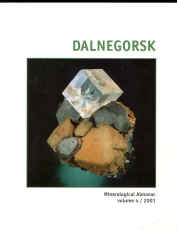
This 128 page softback of the Mineralogical Almanac series is devoted to the Dalnegorsk deposits. It is the best book you can buy bout this deposit in English. It has nice and clear descriptions of the local geology and the structures of the different deposits. Loads of pictures and accurate mineral descriptions. With this book, Dalnegorsk has a lot less mysteries for you!
The book is available here
Mineralogical Almanac No 7
Kukisvumchorr
I.V. Pekov & A.S. Podlesnyi
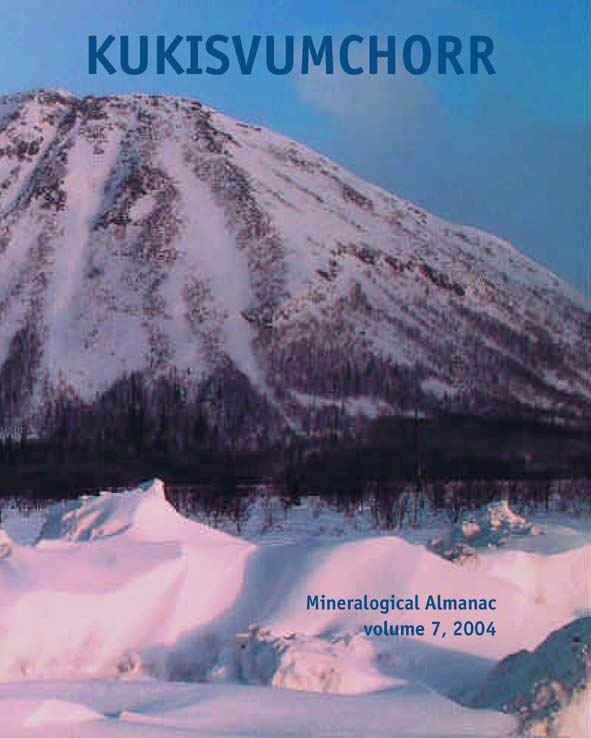
This softback book is full of of very interesting information about Kukisvumchorr and it's Kirovsky mine. The first 53 pages are devoted to local history and geology. Very interesting is the part where individual pegmatitic and hydrothermal veins are described. The next 73 pages are used to describe the minerals known from Kukisvumchorr. In the style of Pekov, illustrated in 'Minerals discovered...' no useless data on hardness and density. Data given is focussed on occurrence and visual appearance. This section has many crystal drawings and black and white SEM photo's. After a few tables, references and index follow 24 pages of full color mineral photographs.
All in all this book is great for collectors of Kola minerals and alkaline mineral collectors in general. Much of the information given can be applied to other localities in Khibiny as well. The book is available here
Khibiny
Victor Yakuvenchuk et al
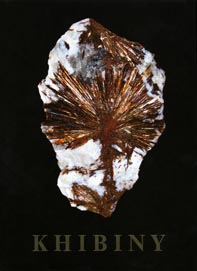
'Et al' are Gregory Ivanyuk, Yakov Pakhomovsky and Yuri Men'shikov. The book is published by Laplandia minerals in 2005. Good recent
books about Lovozero are available in English for some time, but there was not a
good comprehensive book about Khibiny. Until now! This 466 page book is an
absolute must for the Kola collector! What struck me first is the good quality
paper, clear colorful maps and diagrams and a huge amount of impressive photos.
There are many pictures of minerals (both color and SEM) and many
pictures of the Khibiny massif itself. These show not only the interesting
localities and geological phenomena, but also the great nature.
The book follows the basic structure of describing a bit of scientific history,
the local geology, a (large) selection of localities and veins, followed by a
describtion of all currently known minerals from Khibiny. The geology section
has a very illustrative section on the local rocks with great color pictures of
the different alkaline rocks. Each mineral description mentiones cell data,
occurrence and morphology, optical and physical properties, chemistry (with
analyses), alteration and XRD peaks with intensities.
Concluding this high quality standard book is a real
contribution to the current available literature on Khibiny. A great addition to my library!
The book is available here (Laplandia
minerals, sent from Finland)
Lovozero Massif
I.V. Pekov

What can I say. Again a masterpiece of Igor Pekov. These comments are getting boring. The book features an elaborate history of explorations of the area.There are many interesting historical pictures. Although the author apologises for not describing Lovozero's geology in full detail, because this is beyond the scope of this book, he still did a pretty impressive job with 12 pages about the geology and a subsequent 59 pages about pegmatites and hydrothermalites. The second part of the book is devoted to mineral descriptions, again focussed on occurrence and visual appearance. Many pictures, crystal drawings and SEM photo's illustrate this chapter. The only drawback of this book is that it is from 2000 and a lot of new minerals have been discovered since then. But that is a problem you will always face in a area that is still studied so intensely as Lovozero.
Defenitely a must for the Kola collector. The book is available here
The Lovozero Alkali Massif
Vlasov, Kuz'menko and Es'kova
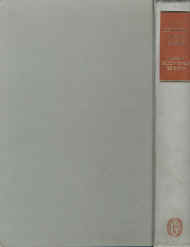
Published in 1966 by Oliver and Boyd as an English translation of the orginal Russian book, this is still an important monography of the Lovozero massif. At 627 pages this book is an overkill even for the hardened Kola collector. The book is divided into four parts. The first part of 56 pages is devoted to the geological and chemical-mineralogical composition of the massif. Part two of 163 pages is devoted to the pegmatites, describing countless individual pegmatites all over Lovozero in great detail. Part three of 259 pages deals with the individual minerals. Here all then known Kola minerals are described in great detail. The final part four discribes the geochemistry and genese of the massif in just under 100 pages.
Of course the book is written several decades ago,but it still is a good solid foundation for any Lovozero study and certainly a book to keep looking for.
Mineralogy of Hyperagpaitic Alkaline Rocks
A.P. Khomyakov

Published in 1995 by Clarendon press, Oxford, UK. A very usefull
book for anyone interested in the mineralogy of Khibiny and Lovozero. The book
gives detailed information on many rare to very rare minerals from these
localities.Much of this information was never published in English before. The
book briefly explains the geology of Khibiny and Lovozero and characterises a
number of types of post magmatic vein systems and their typical mineralogy. One
chapter is devoted to less stable minerals with interesting chemical reaction
between minerals and liquids. The better part of the book is devoted to mineral
descriptions. Where the mineral is found, in what paragenese, what it looks like
and a number of physical parametsrs. These include the not yet IMA accepted 'M'
minerals.
The book is certainly not "a complete guide of....". It focusses on
the true hyperagpaitic minerals. This means that the low and medium agpaitic
minerals such as Astrophyllite, Titanite or Eudialyte are not explicitly dealt
with. A little annoying is a number of small shortcommings. For instance it says that
Clinophosinaite occurs at two localities in Khibiny, but names only
in somewhere in a table. There are also some annoying errors or typo's in the
tables. Minerals that are attributed to two localities (tetranatrolite in table
3.7), or parts of tables missing (only 15 analyses in Table 3.10 where there
should be 21 according to the text below the table) For most discussed minerals the book provides the most
important XRD peaks, but fails to provide their relative intensities.
Despite these shortcommings this book will be valuable for the advanced
collector of Kola minerals.
The Geochemistry of the Lovozero Alkaline
massif
V.I. Gerasimovski et al
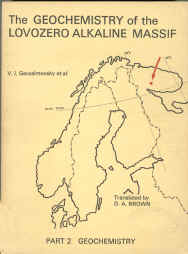
Published by the Australian National University press in Canberra in 1968. The original Russian book is from 1966. The book consists of two volumes. Volume one of 224 pages deals mainly with all the different magmatic phases describing the rocks in detail. Part two of 369 pages describes all chemical elements and their geochemical properties related to the Lovozero massif. Both books are very interesting for the more advanced Kola collector, who is interested in petrological and chemical backgrounds. Do not expect any usefull minerals descriptions or elaborate descriptions of paragenesis of pegmatite veins. If you look for that go for the Pekov and Vlasov books. But if you always wanted to know that the Galena at Lepkhe Nelm contains about 0.09% selenium, or how titanium behaves in an alkaline intrusion, this is a usefull book. At the end of volume 2 is an appendix with a short description of all then known minerals from Lovozero and where (or how) they occur.
Zarenschätze
P.Kolesar and J. Tvrdy
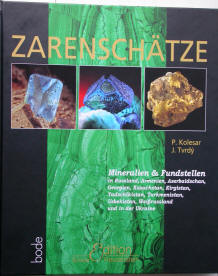 If you like my website, you will like this book. A whopping 720 pages of Russian
mineralogy! Published by Bode Verlag in 2006. The book appeared 4 years after
this website, but the black, yellow and malachite appearance are striking! And
of course there are more similarities between this site and the book. But hey,
it's about the same subject, what do you expect? Each chapter of the book deals
with a part of the former Soviet Union. Often mineral localities are grouped
together, such as chrome deposits of the Ural or the hydrothermal deposits of
the Carpathians. For each such group the most noteworthy minerals are described.
Although the title might suggest it is more about gems, gold and platinum, the
book is definitely also about the rare systematic minerals. There are plenty of
color pictures of both the minerals and the localities, as well as occasional
diagrams and maps. Although some pictures are familiar if you have Lapis and Mineralien Welt magazines.
If you like my website, you will like this book. A whopping 720 pages of Russian
mineralogy! Published by Bode Verlag in 2006. The book appeared 4 years after
this website, but the black, yellow and malachite appearance are striking! And
of course there are more similarities between this site and the book. But hey,
it's about the same subject, what do you expect? Each chapter of the book deals
with a part of the former Soviet Union. Often mineral localities are grouped
together, such as chrome deposits of the Ural or the hydrothermal deposits of
the Carpathians. For each such group the most noteworthy minerals are described.
Although the title might suggest it is more about gems, gold and platinum, the
book is definitely also about the rare systematic minerals. There are plenty of
color pictures of both the minerals and the localities, as well as occasional
diagrams and maps. Although some pictures are familiar if you have Lapis and Mineralien Welt magazines.
All in all an impressive work, which forms a good basis for the research of
Russian mineralogy. No serious shortcomings, although some of you might struggle
with the German language. Definitely a "must have"!
Ore Deposits of the USSR
V.I. Smirnov

Published way back in 1977 by Pitman publishing in London. The book consists of three volumes. Each chapter is devoted to a single element, like iron, copper or mercury. Individual deposits are usually described in great detail (several pages) including descriptions of the local rocks, shapes of the veins, intrusions or stocks and the mineralogy. All this accompagnied by many sketch maps. Dating back to Soviet times, it is noteworthy that the information on uranium is very sketchy compared to other elements. Many types of uranium deposits are described in detail and with maps, but not a single name of a locality is mentioned :-) A very useful book! It will be hard to get these three books, but it is defenitely worth the efford.
Geology of Mineral Deposits
V.I. Smirnov

Same Smirnov, different book. Published by Mir publishers in Moscow in 1976 and has 520 pages. This book is not about Russian mineralogy, but it deals with different kinds of ore deposits and mineral occurrences. It explains the differences between all kinds of types of deposits. On it's own allready a hugely interesting subject in my opinion. But of course all these deposits have to explained by using examples and since it is a Russian book, most examples are Russian deposits. So browsing this book will reveal many geological sketchmaps and explanations about Russian localities. But in addition to that the book is very interesting and deals with plenty non Russian localities too.
 Geology
of the USSR
Geology
of the USSR
D.V. Nalivkin
Published in 1973 by Oliver and Boyd in Edinburgh. So far this is the best book about the geology of Russia that I came across. It is a very handy book if you want to understand the broader geology of a mineral deposit. The book has 855 pages, so you understand it is pretty complete. It deals with tectonics, stratigraphy and magmatics for each geological area in the former USSR. Apart from the geology the book also lists a limited number of important and interesting mineral deposits. If I were you I would put this one on my birthday wishlist!
Active Volcanoes of Kamchatka
S.A. Fedotov
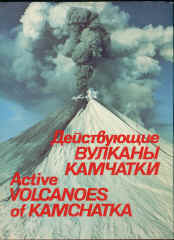
Published in 1991 by Nauka Publishers in Moscow. This book consists of two volumes. It is a large (larger than A4) format book. Volume one is about the northern Kamchatkan volcanoes, and volume two deals with the southern ones, which is south of Kronotsky. Each chapter deals with one active volcano. The chapters are in Russian with numerous tables, pictures, graphs and maps. At the end of each chapter is a complete translation in English. Absolutely the best books on Kamchatkan volcanoes I have ever seen. Stunning pictures combined with good solid scientific information. There is only one drawback to this book and that it is so darn hard to get it. I searched every bookstore in Moscow and on Kamchatka ( yes there about 10 bookstores on Kamchatka!) without success. I got my copy in the end from a retiring volcanologist on Kamchatka.
Mineralogy of Carbonatites
Yu. L. Kapustin
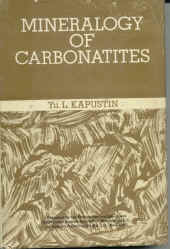
This book measures about 24 x 15 cm and contains 259 pages. It was first published in Russian in 1971 by Nauka Publishers in Moscow. This is the English translation of 1980. The editor in chief is E.I. Semenov. Although this book is about carbonatites in general, it discusses Russian carbonatites in more detail. The book has some small sketchmaps of worldwide carbonatites and a few black and white photographs. To me the best thing about this book is that it explains the formation and rocks of these rather complex localities in an understandible way. Carbonatites are usually formed in several stages, all with different rocks and different mineralogy. Both the stages and the rock types, as well as 117 different minerals are described here. The mineral descriptions often come with analytical data. Of course the book is a little older and the insights in the complex carbonatites change rapidly, but now I know at least what a Damkjernite or a Turjaite is. A handy book to have on your desk while sorting out your Kovdor or Vuorijarvi specimen.